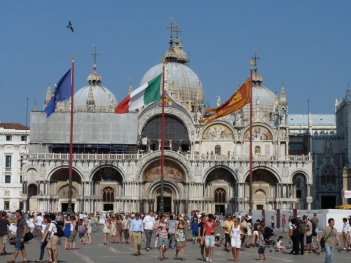
Care to brave the tourist crowds at a European landmark like St. Mark’s Basilica? Be prepared for approaching vendors.
Aggressive salesmen can sully the best of romantic, city-wandering moods, whatever country they come from or reside in.On my just-finished trip to Europe, though a direct “No!” goes against the improvisor’s grain of accepting and advancing all offers, I did ultimately find some successful refusal techniques. More importantly, I also found that developing compassion for these men proved the best way to soften their imposition.
In every country I visited, I encountered dudes—and it was always men—trying to sell me cheap goo-gaws. In Edinburgh, they hawked Braveheart pins. In London, Olympic flags. In Paris, models of the Eiffel Tower: “Just one euro!” Some were wilier than others. One fellow in Paris ‘offered’ a rose to Melissa as we walked by and swore he wasn’t trying to sell us anything. No, it is a gift for the lovely lady. She is beauty and love and Paris. It is from me to her. He continued to insist over our protests that this wasn’t a sale, but then, when we shrugged and started to walk away with the flower, he grabbed my arm and said, You need to pay. Ugh. Take the dang thing back.
The craftiest was the Roman centurion at the Arena in Verona. He caught me a bit off-guard because he came out from under the ancient arches into the entrance line, so I assumed he worked for the facility itself. Without any words, he used his play-gruff manner to pull Melissa into a pose and then drew me into a back-and-forth improv, making mime jokes comparing my bald head to his well-polished helmet. We had a good laugh and took a few photos, not expecting him to then lift his little sack of coins in our faces afterward. He made good use of his costumed role, exerting a bit of faux-but-not-faux aggression. When I gave him one euro, he looked back with a “you’ve got to be kidding” stare and jabbed his sword while shaking his money bag. I tossed him another two coins. You had to hand it to him: a Roman brute would shake you down.
Other hawkers proved just plain annoying. In Venice, a city draped in romance, the rose-sellers creep and lurk around every corner. Having a quiet dinner at a side-alley table? He’ll pop up from behind the plant box. Enjoying a sweet sashay to the live music in St. Mark’s piazza? He’ll interrupt your lovers’ gaze with a flower between your faces. Really, they knew no bounds. To these Venetian ‘vendors’, any hint of affection on your part becomes a sales opportunity on theirs.
The “firefly” guys of St. Mark’s plaza got me thinking more deeply about this whole thing, though. On our initial night in Venice, Melissa and I had both been stunned when we first crossed a little canal and walked under an archway into the classic open-air square.
Hundreds of folks were strolling about, gathering in groups to listen to live music stages around the edges. Children and parents were playing in the center and others milled in front of the famed Basilica and clock tower at one end of the piazza. Throughout the space, dozens of little, blue lights shot up into the air and then floated quietly down, a phosphorescent blend between fireworks and fairies. We loved the magical, breathtaking atmosphere.
Of course, our wide eyes following each mini-dazzler only sounded the signal to sell. Within moments, we were accosted by several men of South Asian descent, each trying to unload the battery-lit slingshot toys. For your wife, one would say. Just two euros. A few feet later, another would approach: Signore, I give you good price. How much you want? The parade became as predictable as it was bothersome.
If we were going to enjoy St. Mark’s at night during our trip, we needed to find a creative plan for effective refusals. At first, I tried a little improv ‘Yes, and’ approach. When a vendor stepped up and said It’s magic. Your kids are love it, I replied with You’re so right. It is magic. Maybe your kids would love it! That spun him off into the night a bit confused. My strategy had worked, but had also taken more energy than I wanted to expend.
With another, I tried using a set of breadsticks leftover from dinner. When he held out the toys, I preempted his sales pitch with one of my own: I’ll trade with you. You take the breadsticks, I’ll take the flyer. He chuckled and shook his head—No, no. You mangia. You mangia.—and then left us alone. We’d stepped out of the trance routine and interrupted his scripted flow.
Ultimately, the most efficient, most effective deterrent proved to be the Heisman Trophy technique. When someone approached, we would avoid eye contact, put on a stern and disapproving frown, and hold our hand out at a stiff-arm length. It was a quick maneuver, but they got the message, peeling away like pipsqueak defenders.
Before we got to that point, though, we also tried engaging the men in conversation. Let’s dive into the distraction, I convinced Melissa. There’s got to be a story here. Sure enough, there was. It turns out that most of these men came from Bangladesh doing their best to make a living for their families. Most live in Mestre on the mainland, trying to find work over there. When work is scarce, they come over to the Venetian islands each night to sell what they can. On a good night, they’ll sell 10 or 20 of the firefly toys a night, ranging between two to three euros a piece. On a bad night, they might sell five—or even none. I buy a case of them for 50 cents each and then adjust my price based on the customer, one vendor told us. If they seem wealthy, I might ask for five euros. If it’s a little kid, I’ll give it to them for one.
These guys aren’t dumb. One man we talked with proudly shared that he could speak Hindi, Erdu, Arabic, Italian, and “just a touch of English,” just enough to communicate with us. They’re not predators, either, though a closed-hearted resistance can make them seem that way. They’re friendly with each other and generally gentle, if shameless, in their sales approach. They’re not Roman centurions extorting tourist cash. They’re independent guys working at making their way in the world.
One of Venice’s great landmarks is the Bridge of Sighs. When criminals in the early city days received a sentence, they would have to use the white arch, crossing from the ornate governmental halls of the Doge palace to the dreary underworld of the medieval prison next door, sweltering in summer and frigid in winter.
Small, stone windows in the bridge look out on the canals and bustling port of Venice, offering one last, fleeting, mournful glimpse of a life being left behind.
Legend has it that the prisoners moans could be heard throughout the city as they made their way across. Striking in its beauty and its purpose, the bridge stands as a symbol of both Venice’s glory and its melancholy.
It also reminds me of the flower- and firefly-selling vendors. These men, many of them far more skilled than their ‘work’ suggests, have crossed over one of life’s canals, leaving the familiar comforts of home for a more uncertain life halfway across the globe. What family, what friends did they have to leave behind? What vistas will they never see again? Perhaps they were sold on a promise of possibility but have become locked into a more desperate, more tenuous existence. It can’t be fun to try to sell these things night after night, getting refusal after refusal. Even the best of financial evenings won’t reap a windfall.
Once we shared a few words with these men, they became more human—and isn’t that how compassion works? When we know the story behind the behavior, our judgment softens into understanding. It doesn’t mean we want to have our romantic moments interrupted or that we care to be approached—again—for another trinket sale. But it does mean that our frustration gets placed in context. We can allow a connection. We can enjoy more humor. By the end of our trip, Melissa and I did come to employ the Heisman technique, but we managed to do so without malice, knowing we were playing a game. We also decided to bring two of the firefly toys home.
On our last full day in Venice, taking a walk through another part of town, we spied from a distance one of the vendors we had spoken with a few night’s before in St. Mark’s Plaza. This time, he was selling splat toys, slimy tomato- or grape-shaped absurdities that would squish on contact with the ground before oozily reconstituting themselves back into original shape. Just one euro, we overheard him say to other tourists. Your kids will love them. As Melissa and I approached and passed by, we shared a smile and wink of recognition. He smiled back without asking for a sale.
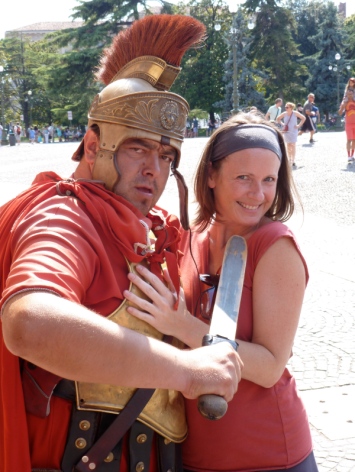
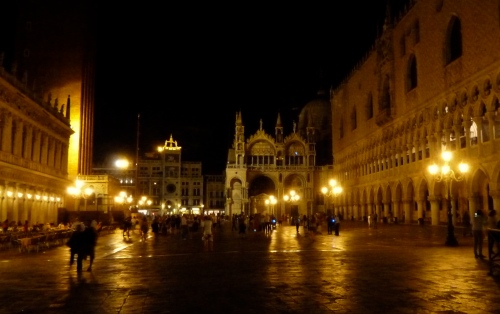
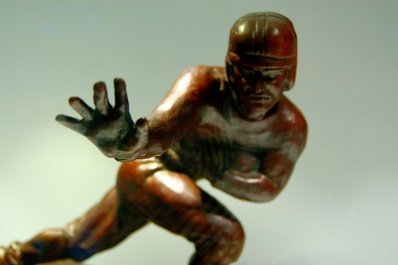
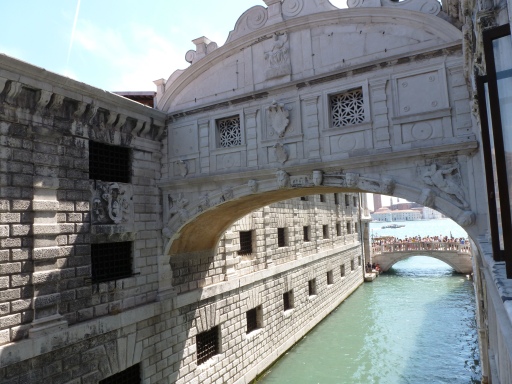
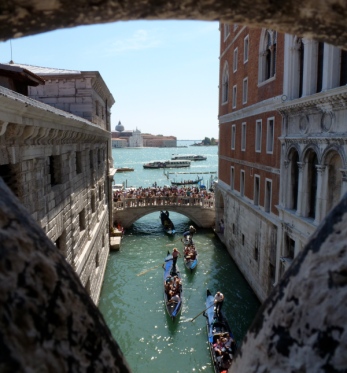
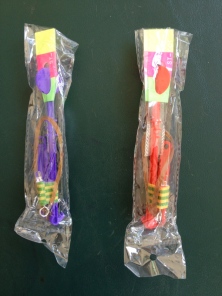
Loved this. Especially the description of the sales-y veneer and then the real story underneath it. There’s almost always a real story. And once you got the story, your level of connection changed–at least with the splat-toy vendor. I could see a guidebook in the making, matching toys and vendors with popular European landmarks. A little profile of each person (the real story). Have you seen that website “Humans of New York” (http://www.humansofnewyork.com/)…beware, addicting, but kind of like that…pics with a profile… y’know, in all your free time.
That is a great idea, Laura. I’d heard about the Humans of New York site but hadn’t yet seen it–and, yes, that could prove a huge and compelling time vacuum.
I’m always curious about the real stories behind the veneer. Look for more of that in an upcoming post that pulls together thoughts about Venice on the whole. It’s a fascinating place. Simply fascinating.
Thanks for reading and commenting!
NOW I know what those little toys were on the table on the deck!!!!
I’m glad you challenged yourselves to ask and really hear the story behind the people and salesmanship:)
I’m not sure how I would have handled the flower popping up between an about-to-be romantic Venice or Paris kiss:) But I do like the description of the Heisman move and the helpful reminder photo:)
J-bird